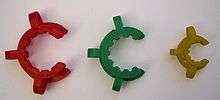Joint clip
Joint clips are used to prevent a joint from separating during a reaction process. They are used to secure the two sides together and are available in a variety of materials for different temperature and chemical environments.

Plastic joint clips
Plastic joint clips are usually made of polyacetal, and are colored according to joint sizes. Polyacetal melts at a reasonably low temperature (around 175 °C) and begins to soften around 140 °C. As glassware temperatures are recommended up to 250 °C, care needs to be taken that clips made from this material are not being used to hold glass together that will get this hot. Typical problem areas include a flask over the plate (which may drop off the end of the column as it gets hot) and the connection the condenser makes to the still head (which will reach high temperatures and may allow the condenser to fall off). As such, different clips should be used at these points or the glassware should be clamped such that these elements can't slide apart or don't need the clip. Polyacetal clips suffer another problem in that the material is strongly affected by the corrosive gases. This effect can be so dramatic that the clip will fall apart in minutes of exposure to minute quantities leaking through even greased, ground tapers. Importantly, this failure mode is sudden and without warning.
PTFE joint clips
PTFE joint clips are sometimes used, as its recommended temperature peak matches that of most practical chemistry work. Its highly inert nature also makes it immune to degradation around the corrosive gases. However, it is both expensive and will begin producing hydrogen fluoride if heated to beyond its specified temperature; so care must be taken to avoid this, given the level of risk the result presents. The same is true of using Krytox and chemically resistant Molykote (PTFE thickened, fluoro-based) oils and greases for glassware seals.
High grade stainless steel joint clips
A high grade stainless steel joint clip is a final option. Naturally, this can withstand the entire temperature spectrum of borosilicate glass and is reasonably inert.
Some glassware features barbs (Devil's horns / Viking helmet) sticking out the sides of the tapers. Small stainless steel springs are used on these to hold the joint together. The use of springs is of particular benefit when dealing with positive pressures, as they apply enough force for the glass to operate, but will open the taper if an unexpected excursion occurs. This method is considered quite old fashioned, but is still used on some of the most well known and high end glassware available.